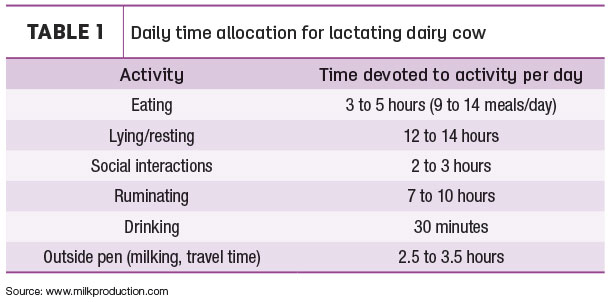Recently, researchers and producers have put more attention on creating a comfortable environment for dairy cows and their replacements. Observation and experience show cows housed in a comfortable environment produce more milk and generally live healthier, longer lives. Cows cannot explain what makes them comfortable.
However, we can observe and measure cow activity, behavior and environment – then correlate our observations with what appear to be comfortable cows. Cows should have plenty of quality feed and water, fresh air, a soft and clean resting surface plus sound footing. Cows should behave naturally and stand or lie down easily. Is that happening in your dairy?

Let’s look at some of the areas where cow comfort can influence farm profitability. Start with the cow and its activities during a 24-hour period.
Cows should spend 50 to 60 percent of their time lying down. Their time lying down is divided into 10 to 14 periods per day, each of about 60 to 80 minutes duration. Some cows lie down as much as 20 times per day. After each milking, cows should lie down for at least 90 minutes.
On average, a cow will spend four hours at the feedbunk per day. To ensure good feed intake, not only is the quality of the feed important, but it is also essential there is sufficient space for the animals to feel comfortable at the feedbunk. Small portions are healthier for cows than large volumes all at once.
Lameness will also influence cow comfort. To support the natural intervals of resting, feeding, drinking and social interactions, good locomotion and healthy dewclaws are important. Score the lameness of your cows according to a standardized scoring method. This will help identify potential problems before a cow becomes obviously lame.
It may be impossible to eradicate all lameness on farms, but the goal should be to eliminate clinical lameness and achieve a level whereby around 65 percent of the herd has a score of 1, and only 5 to 10 percent have a score of 4. Cows with a score of 5 should be removed from the main herd to recuperate in a treatment area. Locomotion scoring does not identify why a cow is lame; it only serves as an indicator of which cows may be lame. Bear in mind, a poor locomotion score may not always be due to a problem with the hooves or legs but could also indicate conditions such as acidosis or a displaced abomasum.
Your cows are continually telling you how well you are doing in providing them with good health, excellent housing and superb feeding, which are indicators of cow comfort. Additional areas to focus observations on include heels, the neck and breathing patterns:
-
Heels: Check cows’ heels for heel erosions or skinned heels. These signs could indicate there is something wrong with your bedding.
-
Neck: Check cows’ necks for swelling or hair loss. This likely indicates a problem with your feed rail.
- Breathing: Check the breathing of your cows; they should breathe 10 to 30 times per minute. Differences are an indication for heat stress.
Resting time is crucial. Dairy cows rest 12 hours per day in approximately 1.5-hour increments in the stall. This means the cow lies down to rest and rise up about eight times per day.
The cows need a soft, non-slippery surface and enough space to lie down and rise in a natural way. The divider should guide the cow and not disturb it. Cows should not stand in the stall. They should lie straight, not diagonal, and the stalls have to stay clean and dry.
Why is resting important? The cow rests and ruminates when lying down. This allows the hooves to rest and dry off, and there is more space for other cows to walk around in the barn. Blood circulation through the udder increases by up to 30 percent, which contributes to more milk production.
A quick evaluation can be done using the Cow Comfort Quotient (CCQ), developed by Ed Jaster of California Polytechnic State University. Simply count the number of cows lying properly over the total number of cows in the stalls. The goal should be at least greater than or equal to 85 percent CCQ. If the goal is not met, then it is a good indication improvements should be made.
The modern, highly productive dairy cow needs to be served year-round with optimal climatic conditions. Above 71ºF, cows start reducing their feed intake, need energy to get rid of excessive heat production and, therefore, start losing the usual high milk production levels. This means cows require a good air/ventilation system.
There are two basic types of ventilation: natural and mechanical. Natural ventilation does not just happen naturally; it must be planned for so it will work correctly. Natural ventilation uses local, natural air currents along with temperature differences between the inside and outside of the building to move air through the structure. Mechanical ventilation supports natural ventilation by forcing air exchange with the use of fans and controlled inlets.
Clean water is a cow’s most important feedstuff. More water leads to increased feed intake which, in turn, leads to more milk. Water also regulates the body temperature and is vital for organic functions such as digestion, waste removal and absorption of nutrients. Tests show a 40 percent reduction in water intake might cause a 25 percent decrease in milk production.
A high-yielding cow needs 25 to 40 gallons of water per day. A cow needs 3 to 4 quarts of water to produce 2.2 pounds of milk. A portion comes from the feed ration, and the rest has to come from the water supply system. It is very important the water supply system is therefore adequate. Cows need fresh and clean drinking water. Ideal temperature is around 63ºF. Cows will drink more and, in cold conditions, cows will use less energy to “heat” the water to body temperature.
With these factors in mind, budgeting for cow comfort improvements can be well worth the investment. There are many areas where cow comfort can improve milk production, resulting in a more profitable dairy operation. Observe where in your dairy improvements can be made and prioritize where cows will benefit the most. You will not regret it. ![]()

-
Yves St-Onge
- Channel Sales Representative
- Quebec Market
- Email Yves St-Onge






